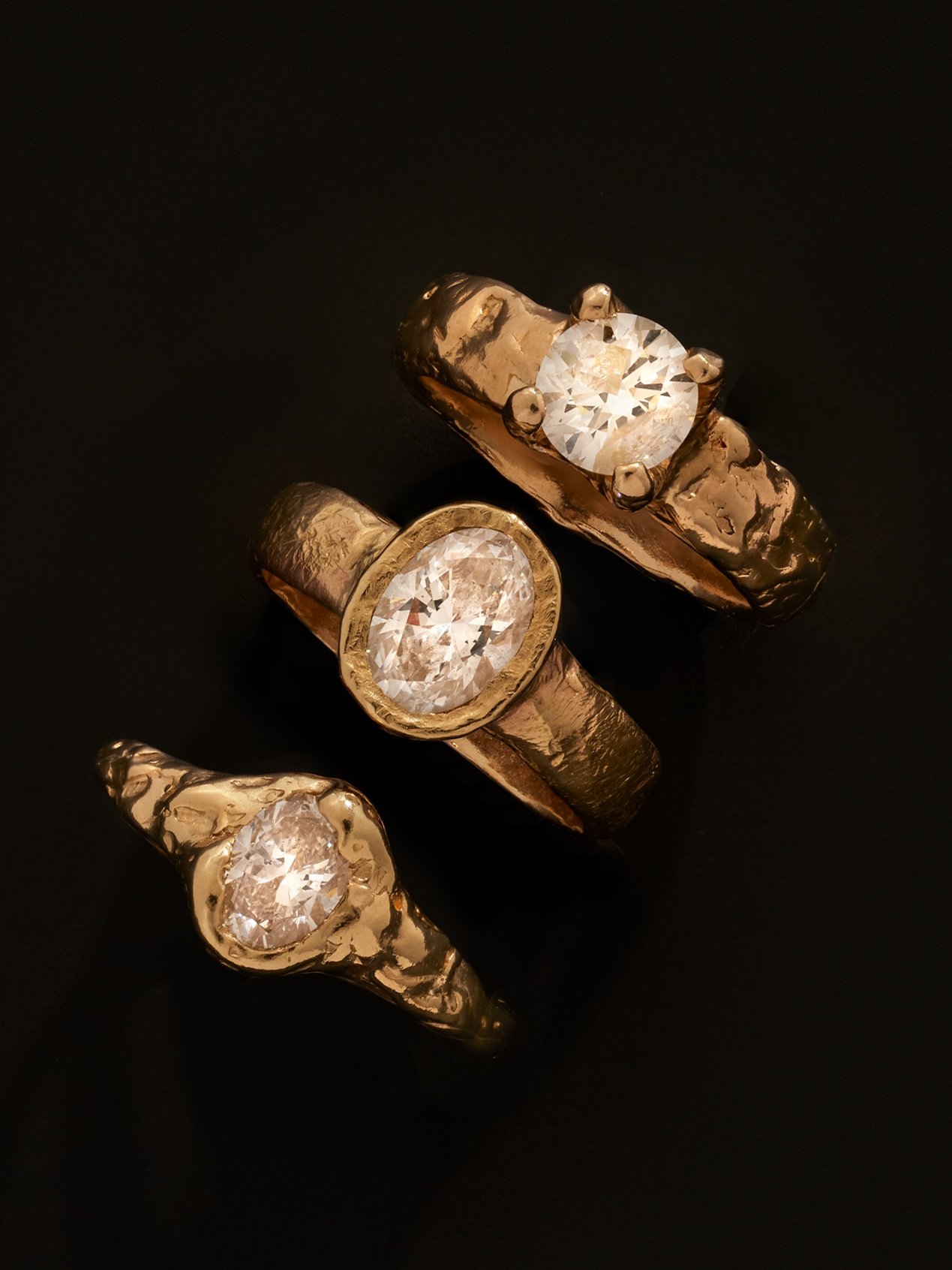Diamonds
Each and every diamond holds it’s own unique properties. Learn all about the different diamond cuts, colours & inclusions.
The diamond takes its name from the Greek word adámas, meaning unconquerable. Formed 200km beneath the earths surface, they exhibit the worlds strongest mineral composition. Diamonds take an estimated one billion to three billion years to form and exhibit a dazzling variety of colours and inclusions which reflect their unique mineral environment. These incredible gemstones are often thought of as a physical manifestation of the earth’s historical memory. They are revered the world over for their unique ability to refract brilliant light when cut.
Why Choose Diamonds?
When cut, diamonds have an incredible ability to refract light, outshining other gemstone choices. They are also the most durable gemstone, meaning your special diamond pieces will last many life times.
Pictured - the Ethereal ring featuring a 0.5ct brilliant cut white diamond & the Aurora ring with a 0.5ct oval cut white diamond.
Raw Diamonds
Raw diamonds refer to gemstones which are in their natural organic state. They are uncut and untreated. Each raw diamond holds its own unique properties that result from its formation process – therefore the shape and size of every raw diamond is unique.
Pictured - two hand crafted one of a kind piece’s featuring raw diamonds, cast in 100% recycled metals.
Salt & Pepper Diamonds
Salt & pepper diamonds exhibit unique inclusions which create a stunning speckled appearance. These patterns form organically and vary from dark and moody, light and sprinkling or icy white. Each diamond displays a unique constellation of inclusions that result from the minerals found in their individual formation environment. The ‘pepper’ refers to their black inclusions while ‘salt’ refers to their icy white inclusions.
Traditionally diamonds of rare colouring and perfect clarity have been thought of as the most desirable. Inclusions were generally considered less appealing. In recent years, the beauty of these unique inclusions has been rightly recognised and sought after. It is important to note that the chemical structure and hardness of all diamonds are the same.
As these unique gemstones have been recently introduced to the popular market, there is not yet a grading system to categorise their appearance. Therefore they cannot not currently be provided with a certificate.
Diamonds come in a wide range of colours and exhibit various inclusions. They can be found in white, champagne, cognac, yellow, pinks as well as blues and blacks. They can even be found in reds – considered the rarest diamond colouring.
Diamond Colours
Pictured - a geometric trilliant cut claw set champagne diamond. To the right a trillion cut white diamond in a bespoke 14ct yellow gold band.
Here in Australia, the now closed Argyle mine was once the worlds largest supplier of pink and red diamonds. This mine also produced a large amount of champagne and cognac diamonds. This mine has since closed in recognition of land rights of the original custodians of the land.
Colour Scales
Pictured - a C-2 brilliant cut champagne diamond & a C-6 brilliant cut champagne diamond.
The colour of a diamond is categorised by a colour scale. When sourcing a champagne diamond for example, the colouring can be identified by a colour category.
C-1 to C-2 Light Champagne
C-3 to C-4 Medium Champagne
C-5 to C-6 Dark Champagne
C-7 – Cognac
The Champagne Colour Scale
Black diamonds are a result of a high concentration of dark inclusions. These inclusions are formed from trapped clusters of graphite or carbon in their growth environment. When they become tightly clustered together they create a dense night black.
Black Diamonds
Pictured left - the Immerse ring in 9ct yellow gold with an embedded 2.75mm round cut black diamond. Above - a bespoke wedding set in 9ct yellow gold featuring the Eros band and a claw set pear cut black diamond.
Diamond Grading & the Four C’s
The diamond grading process will take into account what is known as the four C’s – cut, colour, clarity and carat. This is how the gemstones unique properties are identified and categorised. From there, the market value of a diamond is assessed.
While the market value of a diamond is based on rarity, clarity and desirability, what an individual will find desirable about any particular diamond is completely up to personal aesthetic preference.
The Mohs Scale
The Mohs scale is the measurement of mineral hardness and ranges from 1-10 with diamonds being the hardest gemstone. Black diamonds, coloured diamonds & salt & pepper diamonds all hold the same chemical hardness. Gemstones are ranked on the Mohs hardness scale as follows.








































